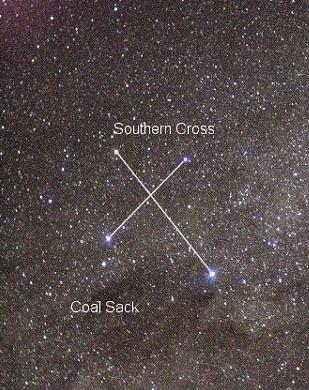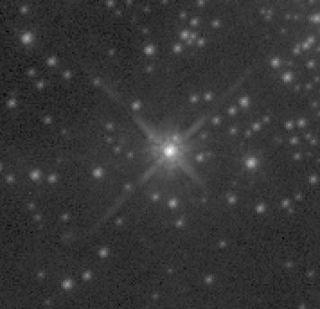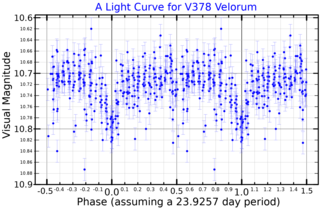
Wolf–Rayet stars, often abbreviated as WR stars, are a rare heterogeneous set of stars with unusual spectra showing prominent broad emission lines of ionised helium and highly ionised nitrogen or carbon. The spectra indicate very high surface enhancement of heavy elements, depletion of hydrogen, and strong stellar winds. The surface temperatures of known Wolf–Rayet stars range from 20,000 K to around 210,000 K, hotter than almost all other kinds of stars. They were previously called W-type stars referring to their spectral classification.

WR 136 is a Wolf–Rayet star located in the constellation Cygnus. It is in the center of the Crescent Nebula. Its age is estimated to be around 4.7 million years and it is nearing the end of its life. Within a few hundred thousand years, it is expected to explode as a supernova.

A hypergiant (luminosity class 0 or Ia+) is a very rare type of star that has an extremely high luminosity, mass, size and mass loss because of its extreme stellar winds. The term hypergiant is defined as luminosity class 0 (zero) in the MKK system. However, this is rarely seen in literature or in published spectral classifications, except for specific well-defined groups such as the yellow hypergiants, RSG (red supergiants), or blue B(e) supergiants with emission spectra. More commonly, hypergiants are classed as Ia-0 or Ia+, but red supergiants are rarely assigned these spectral classifications. Astronomers are interested in these stars because they relate to understanding stellar evolution, especially star formation, stability, and their expected demise as supernovae.

WR 102ea is a Wolf–Rayet star in the Sagittarius constellation. It is the third most luminous star in the Quintuplet cluster after WR 102hb. With a luminosity of 2,500,000 times solar, it is also one of the most luminous stars known. Despite the high luminosity it can only be observed at infra-red wavelengths due to the dimming effect of intervening dust on visual light.

HD 5980 is a multiple star system on the outskirts of NGC 346 in the Small Magellanic Cloud (SMC) and is one of the brightest stars in the SMC.

WR 46 is a Wolf-Rayet star in the constellation of the Southern Cross of apparent magnitude +10.8. It is located at 55 arcmin north of Theta2 Crucis. The star is a member of the distant stellar association Cru OB4, and is around 2,900 parsecs or 9,300 light years from the Solar System.

WR 25 is a binary star system in the turbulent star-forming region the Carina Nebula, about 6,800 light-years from Earth. It contains a Wolf-Rayet star and a hot luminous companion and is a member of the Trumpler 16 cluster. The name comes from the Catalogue of Galactic Wolf–Rayet Stars.

WR 102c is a Wolf–Rayet star located in the constellation Sagittarius towards the galactic centre. It is only a few parsecs from the Quintuplet Cluster, within the Sickle Nebula.

WR 148 is a spectroscopic binary in the constellation Cygnus. The primary star is a Wolf–Rayet star and one of the most luminous stars known. The secondary has been suspected of being a stellar-mass black hole but may be a class O main sequence star.
WR 156 is a young massive and luminous Wolf–Rayet star in the constellation of Cepheus. Although it shows a WR spectrum, it is thought to be a young star still fusing hydrogen in its core.
WR 142 is a Wolf-Rayet star in the constellation Cygnus, an extremely rare star on the WO oxygen sequence. It is a luminous and very hot star, highly evolved and close to exploding as a supernova. It is suspected to be a binary star with a companion orbiting about 1 AU away.

Melnick 34, also called BAT99-116, is a binary Wolf–Rayet star near R136 in the 30 Doradus complex in the Large Magellanic Cloud. Both components are amongst the most massive and most luminous stars known, and the system is the most massive known binary system.

CD Crucis, also known as HD 311884, is an eclipsing binary star system in the constellation Crux. It is around 14,000 light years away near the faint open cluster Hogg 15. The binary contains a Wolf–Rayet star and is also known as WR 47.

WR 21a is an eclipsing binary star in the constellation Carina. It includes one of the most massive known stars and is one of the most massive binaries.

R145 is a spectroscopic binary star in the Tarantula Nebula in the Large Magellanic Cloud located in the constellation Dorado. Both components are amongst the most luminous known.
WR 3 is a Wolf-Rayet star located around 9,500 light years away from Earth in the constellation of Cassiopeia.

WR 12 is a spectroscopic binary in the constellation Vela. It is an eclipsing binary consisting of a Wolf-Rayet star and a luminous companion of unknown spectral type. The primary is one of the most luminous stars known.

HM 1, also known as Havlen-Moffat 1, is an open cluster located in the constellation of Scorpius, close to the galactic plane. It was first observed by R. J. Havlen and A. F. J. Moffat in 1976. HM 1 is thought to be 9,500 to 12,700 light-years away from the Earth, beyond the Carina–Sagittarius Arm. It is heavily reddened by interstellar extinction, so although it comprises mostly blue-colored stars, it appears brighter for longer-wavelength passbands. It is projected against the H II region known as RCW 121, and appears to be the source of ionization for the nearby regions RCW 122 and RCW 123.

WR 120 is a binary containing two Wolf-Rayet stars in the constellation of Scutum, around 10,000 light years away. The primary is a hydrogen-free weak-lined WN7 star, the secondary is a hydrogen-free WN3 or 4 star, and the system is a possible member of the cluster Dolidze 33. From our point of view, WR 120 is reddened by 4.82 magnitudes, and it has the variable designation of V462 Scuti.

















